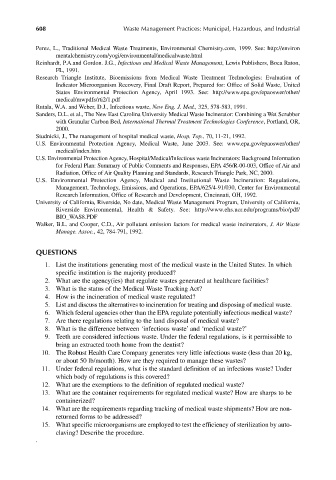Page 637 - Materials Chemistry, Second Edition
P. 637
CAT3525_C20.qxd 1/27/2005 12:54 PM Page 608
608 Waste Management Practices: Municipal, Hazardous, and Industrial
Perez, L., Traditional Medical Waste Treatments, Environmental Chemistry.com, 1999. See: http://environ
mentalchemistry.com/yogi/environmental/medicalwaste.html
Reinhardt, P.A.and Gordon. J.G., Infectious and Medical Waste Management, Lewis Publishers, Boca Raton,
FL, 1991.
Research Triangle Institute, Bioemissions from Medical Waste Treatment Technologies: Evaluation of
Indicator Microorganism Recovery, Final Draft Report, Prepared for: Office of Solid Waste, United
States Environmental Protection Agency, April 1993. See: http://www.epa.gov/epaoswer/other/
medical/mwpdfs/rti2/1.pdf
Rutala, W.A. and Weber, D.J., Infectious waste, New Eng. J. Med., 325, 578-583, 1991.
Sanders, D.L. et al., The New East Carolina University Medical Waste Incinerator: Combining a Wet Scrubber
with Granular Carbon Bed, International Thermal Treatment Technologies Conference, Portland, OR,
2000.
Studnicki, J., The management of hospital medical waste, Hosp. Top., 70, 11-21, 1992.
U.S. Environmental Protection Agency, Medical Waste, June 2003. See: www.epa.gov/epaoswer/other/
medical/index.htm
U.S. Environmental Protection Agency, Hospital/Medical/Infectious waste Incinerators: Background Information
for Federal Plan: Summary of Public Comments and Responses, EPA 456/R-00-003, Office of Air and
Radiation, Office of Air Quality Planning and Standards, Research Triangle Park, NC, 2000.
U.S. Environmental Protection Agency, Medical and Institutional Waste Incineration: Regulations,
Management, Technology, Emissions, and Operations, EPA/625/4-91/030, Center for Environmental
Research Information, Office of Research and Development, Cincinnati, OH, 1992.
University of California, Riverside, No date, Medical Waste Management Program, University of California,
Riverside Environmental, Health & Safety. See: http://www.ehs.ucr.edu/programs/bio/pdf/
BIO_WAS8.PDF
Walker, B.L. and Cooper, C.D., Air pollutant emission factors for medical waste incinerators, J. Air Waste
Manage. Assoc., 42, 784-791, 1992.
QUESTIONS
1. List the institutions generating most of the medical waste in the United States. In which
specific institution is the majority produced?
2. What are the agency(ies) that regulate wastes generated at healthcare facilities?
3. What is the status of the Medical Waste Tracking Act?
4. How is the incineration of medical waste regulated?
5. List and discuss the alternatives to incineration for treating and disposing of medical waste.
6. Which federal agencies other than the EPA regulate potentially infectious medical waste?
7. Are there regulations relating to the land disposal of medical waste?
8. What is the difference between ‘infectious waste’ and ‘medical waste?’
9. Teeth are considered infectious waste. Under the federal regulations, is it permissible to
bring an extracted tooth home from the dentist?
10. The Robust Health Care Company generates very little infectious waste (less than 20 kg,
or about 50 lb/month). How are they required to manage these wastes?
11. Under federal regulations, what is the standard definition of an infectious waste? Under
which body of regulations is this covered?
12. What are the exemptions to the definition of regulated medical waste?
13. What are the container requirements for regulated medical waste? How are sharps to be
containerized?
14. What are the requirements regarding tracking of medical waste shipments? How are non-
returned forms to be addressed?
15. What specific microorganisms are employed to test the efficiency of sterilization by auto-
claving? Describe the procedure.
.

